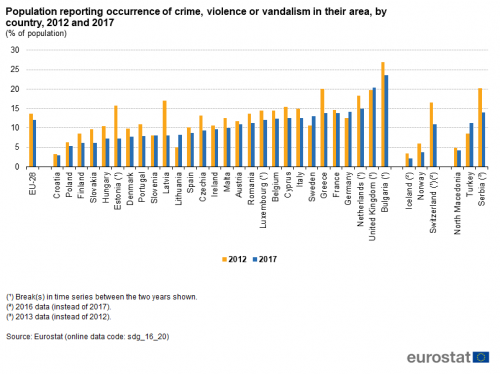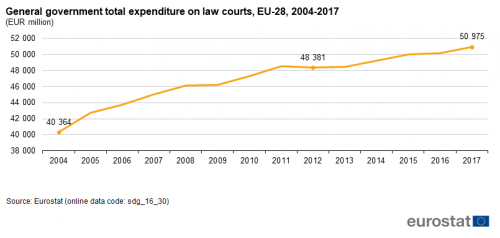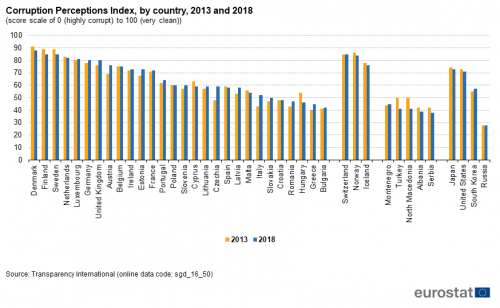Archive:SDG 16 - Peace, justice and strong institutions (statistical annex)
Promote peaceful and inclusive societies for sustainable development, provide access to justice for all and build effective, accountable and inclusive institutions at all levels (statistical annex)
Data extracted in May 2019.
Planned article update: June 2020.
Highlights
This article provides an overview of statistical data on SDG 16 ‘Peace, justice and strong institutions’ in the European Union (EU). It is based on the set of EU SDG indicators for monitoring of progress towards the UN Sustainable Development Goals (SDGs) in an EU context.
This article is part of a set of statistical articles, which are based on the Eurostat publication ’Sustainable development in the European Union — Monitoring report - 2019 edition’. This report is the third edition of Eurostat’s series of monitoring reports on sustainable development, which provide a quantitative assessment of progress of the EU towards the SDGs in an EU context.
Full article
Death rate due to homicide
The indicator tracks deaths due to homicide and injuries inflicted by another person with the intent to injure or kill by any means, including ‘late effects’ from assault (International Classification of Diseases (ICD) codes X85 to Y09 and Y87.1). It does not include deaths due to legal interventions or war (ICD codes Y35 and Y36). The data are presented as standardised death rates, meaning they are adjusted to a standard age distribution in order to measure death rates independently from the population’s age structure.

Source: Eurostat (sdg_16_10)

Source: Eurostat (sdg_16_10)

Source: Eurostat (sdg_16_10)
Population reporting occurrence of crime, violence or vandalism in their area
This indicator shows the share of the population who reported they face the problem of crime, violence or vandalism in their local area. This describes the situation where the respondent feels crime, violence or vandalism in the area to be a problem for the household, although this perception is not necessarily based on personal experience. The data stem from the EU Statistics on Income and Living Conditions (EU-SILC).

Source: Eurostat (sdg_16_20)

Source: Eurostat (sdg_16_20)

Source: Eurostat (sdg_16_20)
General government total expenditure on law courts
This indicator refers to the general government total expenditure on law courts. It includes expenditure on the administration, operation or support of civil and criminal law courts and the judicial system, including enforcement of fines and legal settlements imposed by the courts. The operation of parole and probation systems, legal representation and advice on behalf of government or on behalf of others provided by government in cash or in services are also taken into account. Law courts include administrative tribunals, ombudsmen and the like, but excludes prison administrations.

Source: Eurostat (sdg_16_30)

Source: Eurostat (sdg_16_30)

Source: Eurostat (sdg_16_30)
Perceived independence of the justice system
This indicator is designed to explore respondents’ perceptions about the independence of the judiciary across EU Member States, looking specifically at the perceived independence of the courts and judges in a country. Data on the perceived independence of the justice system stem from annual Eurobarometer surveys, which started in 2016 on behalf of the European Commission’s Directorate-General for Justice and Consumers.

Source: European Commission services (sdg_16_40)

Source: European Commission services (sdg_16_40)
Corruption Perceptions Index
This indicator is a composite index based on a combination of surveys and assessments of corruption from 13 different sources and scores. It ranks countries based on how corrupt their public sector is perceived to be, with a score of 0 representing a very high level of corruption and a score of 100 representing a very clean country. The sources of information used for the Corruption Perceptions Index (CPI) are based on data gathered in the 24 months preceding the publication of the index. The CPI includes only sources that provide a score for a set of countries/territories and that measure perceptions of corruption in the public sector. For a country/territory to be included in the ranking, it must be included in a minimum of three of the CPI’s data sources. The CPI is published by Transparency International.

Source: Transparency International (sdg_16_50)
Population with confidence in EU institutions
This indicator measures confidence among EU citizens in three EU institutions: the European Parliament, the European Commission and the European Central Bank. It is expressed as the share of positive opinions (people who declare that they tend to trust) about the institutions. Citizens are asked to express their confidence levels by choosing the following alternatives: ‘tend to trust’, ‘tend not to trust’ and ‘don’t know’ or ‘no answer’. The indicator is based on the Eurobarometer, a survey which has been conducted twice a year since 1973 to monitor the evolution of public opinion in Member States. The indicator only displays the results of the autumn survey.

Source: European Commission services, Eurobarometer (sdg_16_60)

Source: European Commission services, Eurobarometer (sdg_16_60)

Source: European Commission services, Eurobarometer (sdg_16_60)
Direct access to
More detailed information on EU SDG indicators for monitoring of progress towards the UN Sustainable Development Goals (SDGs), such as indicator relevance, definitions, methodological notes, background and potential linkages, can be found in the introduction of the publication ’Sustainable development in the European Union — Monitoring report - 2019 edition’.








